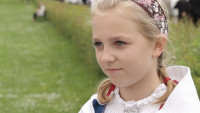Feel Like Going Home Filming Locations
Feel Like Going Home Filming Locations
Transylvania is a region in central Romania. It's known for medieval towns, mountainous borders and castles like Bran Castle, a Gothic fortress associated with the legend of Dracula. The city of Brașov features Saxon walls and bastions, as well as expansive Council Square, ringed by colorful baroque buildings, the towering Gothic Black Church and cafes. Nearby Poiana Brașov is a popular ski resort.
Dinkelsbühl is a historic town in Central Franconia, a region of Germany that is now part of the state of Bavaria, in southern Germany. Dinkelsbühl is a former free imperial city of the Holy Roman Empire. In local government terms, Dinkelsbühl lies near the western edge of the Landkreis of Ansbach, north of Aalen.
Feel Like Going Home (2018)
Transylvanian Saxons are a minority group who were part of Europe's largest mass emigrations within the last 100 years due to factors such as WWII and communism. And yet very little is known about them. They have a long history of traditions, architecture and culture as they emigrated from the Germanic region of Mosel, to what used to be known as the Kingdom of Hungary in the 11th century, which today is known as the Transylvanian region of Romania.. The Saxons formed autonomous villages and cities where they were able to sustain their own culture, language, education and even law for over 800 years resulting in rather peculiar and unique traditions, but are now facing extinction. The documentary will look through the eyes of the younger generations how culture, heritage and rituals can survive in a different context, and how the culture can be maintained after this emigration process. What does it mean to be Saxon? There is a sense throughout of a world which has been lost, a world which appears both idyllic and also rather spooky. Therefore, questions raised in this documentary examine what the future holds for a rich heritage such as that of the Transylvanian Saxons. How much of a culture is left in a place, and how much of a culture is brought into a place by its inhabitants? ? How does the views of the younger Transylvanian Saxons differ from those of their older generation, parents and grandparents? How will they upkeep their vanishing culture and heritage? What will remain for the next generation, and what is done to secure this future?
